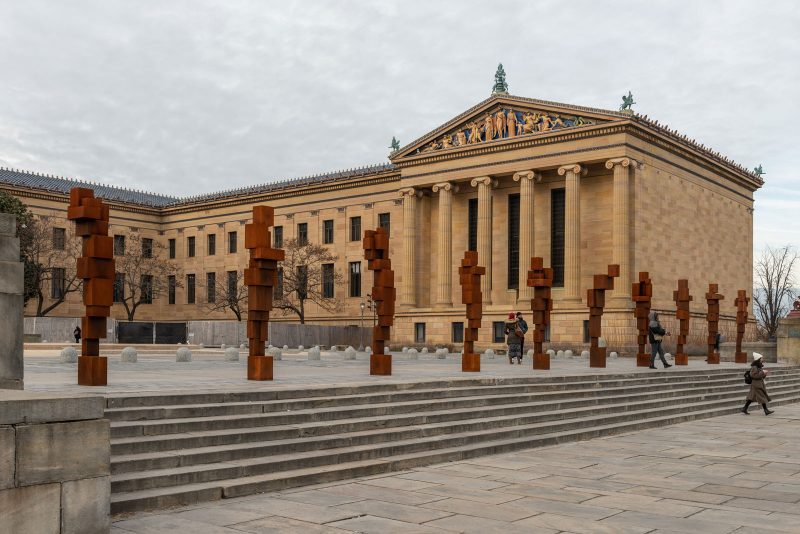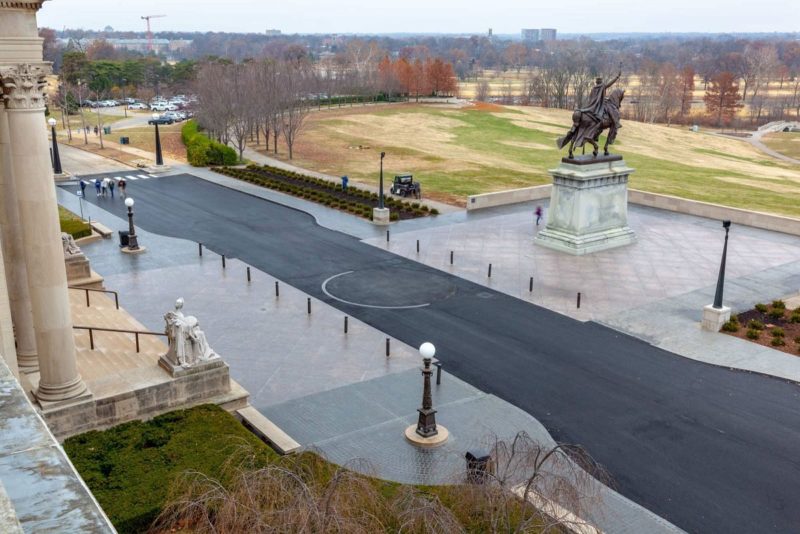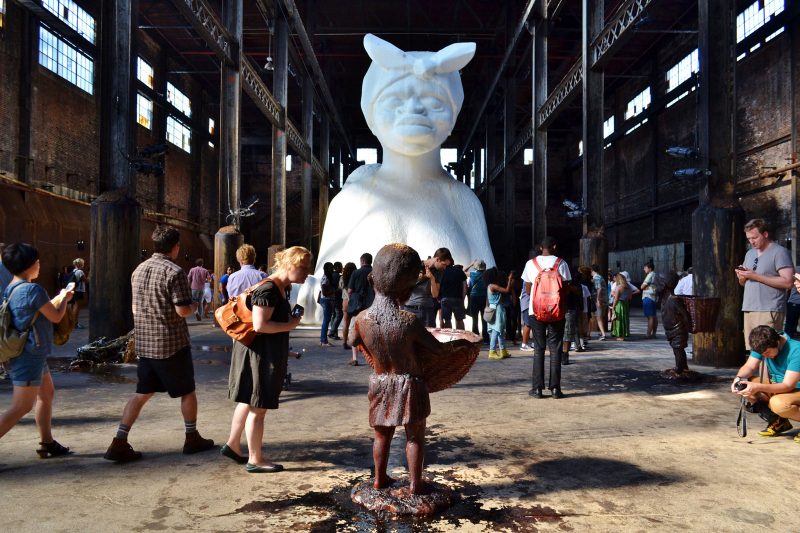
You might have noticed a new series of sculptures at the top of the Rocky Steps on the Philadelphia Museum of Art’s East Terrace. This sculptural group, which is by British artist Sir Antony Gormley (b. 1950), is called “STAND” (2018) and will remain on display at the PMA until June 16, 2019. The ten cast-iron sentinel figures are in Gormley’s trademark “blockwork” style and seem to be a throwback to an earlier era in which highly abstract and simplistic public sculptures with vague and ambiguous meaning were popularized during the fifties and sixties. Several decades removed from the style’s original heyday, however, “STAND”, and other sculptures like it, beg the following question: Why do museums continue to curate these works into civic spaces?
“STAND” can be understood as an extension of a decades-long movement beginning in the mid-twentieth century that moved toward the selection of physically simplistic but conceptually dense works of public art. Curators often place such works in gardens located behind the museum as is the case with the Anne d’Harnoncourt Sculpture Garden at the PMA. Several examples can be seen there now by Sol LeWitt and Scott Burton.
“STAND”, however, is located at the front of the museum. This is a crucial difference. Unlike sculptures located in the PMA’s Sculpture Garden, “STAND” overlooks the Benjamin Franklin Parkway. The Parkway was originally designed to beautify and promote civic virtue in the city. This is still central to its function today, a mission made clear by the several monuments of renowned historical and allegorical figures that decorate the one-mile stretch. Perhaps the most visible example of such a sculpture is the towering forty-four-foot-tall Washington Monument (1897) in the Eakins Oval in front of the eastern terrace of the PMA and directly below “STAND.”
Although both works occupy civic space, the sculptures greatly differ in form and purpose. Washington Monument is an heroic equestrian sculpture that promotes and espouses the democratic and moral values of the United States. In stark contrast, “STAND” is a puzzling group of sculptures that is unheroic and open to interpretation. Instead of espousing a specific point of view, “STAND” conversely seeks to endow the viewer with the power to decide what it means and how they should relate to it. Gormley himself has emphasized these values: “This exhibition is incomplete without the subjective witness of the citizen: each work in its different way calls on him/her to simultaneously project and recognize internal affinities in the attitude carried by the block piles.”

Because “STAND” fosters a relationship exclusively with the viewer, the installation appears nonpartisan to the public, allowing the museum to maintain a politically neutral stance. This explains why museums continue to curate these works of public art. “STAND” does not give the impression that the PMA is weighing in on any real political issues facing Americans today such as unemployment, the nuclear crisis, disability, climate change, gun violence, police brutality, healthcare, racism, or sexism. “STAND” is politically inert and provides a benign option for museum curators.
A similar example of a museum choosing a politically neutral artwork can be seen at the Saint Louis Art Museum (SLAM) where Richard Serra’s “To Encircle Base Plate Hexagram, Right Angles Inverted” (1970) was recently reinstalled after being temporarily placed in storage to accommodate a construction project. Much like “”STAND”, Serra’s work is installed at the front entrance of SLAM overlooking Forest Park, an important site for civic engagement like the Benjamin Franklin Parkway in Philadelphia. Embedded directly in the asphalt in front of the main entrance to the museum, the artwork activates public space, enabling museum-goers to literally stand in the middle of, walk through, and touch the art if desired. And once again, just like “STAND”, Serra’s restrained, geometric visual language also leaves meaning open-ended, empowering viewers to establish meaning. However, the reintroduction of “To Encircle Base Plate Hexagram” neither encouraged applause or fomented public outcry. Most museum-goers do not even notice the steel structure as they walk across it, calling its efficacy as a public artwork into question.

If disengaged works like “STAND” and “Base Plate Hexagram” no longer speak to the current public, it is time for museums to reconsider the works they choose for civic spaces. But to which artists do we look to lead the way? One option is to begin commissioning more public artworks from artists other than white men — artists who have the capacity to spark politically-engaged conversations such as Hank Willis Thomas, Doris Salcedo, and Mickalene Thomas.
American contemporary artist Kara Walker (b. 1969), for example, unveiled her first public artwork, “A Subtlety”, at the Domino Sugar Refinery in New York City on the eve of the factory’s demolition in 2014. Walker’s installation was comprised of several sculptures of children coated with molasses who carried baskets of sugar to a white sphinx. The sphinx evoked the mammy archetype and measured thirty-five feet high and seventy-five feet long. Both the children and the sphinx were made almost entirely from sugar products. As an homage meant to pay tribute to exploited Black laborers, Walker’s installation directly addressed the harsh history of slavery in the U.S.

Prior to the opening of “A Subtlety”, Walker remarked that she hoped that in viewing her installation, the public would be able to take part in a moment imbued with the “weight of memory” – a weight that could create productive conversation among members of the viewing public. While works of art like “STAND” and “To Encircle Base Plate Hexagram” emphasize viewer experience, they do not seem to carry the “weight” that Walker describes. As the public’s voice matters much more to the museum than arguably ever before, perhaps Walker’s artistic ideas can be applied more broadly and museums can begin working more closely with community-members to curate artwork that better suits the public’s needs. This more devoted and intimate relationship between the museum and public promises an exciting age of public artworks as long as both sides remain in close dialogue.
[Ed. note: For more information on Richard Serra’s “To Encircle Base Plate Hexagram, Right Angles Inverted,” which was first installed on 183rd Street in the Bronx, NY in 1970, see this article by Anne Guerra of Untapped Cities.]
Lacy is an art historian, curator, activist, and visual artist. She holds a B.A. in French from Truman State University and an M.A. in Art History and Archaeology from Washington University in Saint Louis where she is currently pursuing a PhD in European and American Modern art. Lacy is also the founder of [ALT+SPACE], a curatorial collective that promotes art appreciation and analysis in Saint Louis, Missouri.









